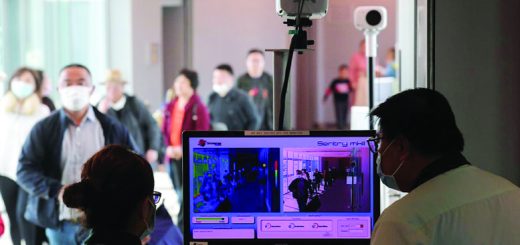The Virus That May Save Humanity
It was the early 1890s, and Ernest Hankin was studying cholera outbreaks along the banks of the Ganges. As the locals dumped their dead in the holy water, the river should have quickly transformed into a poisonous spring of the disease, with an epidemic sweeping through towns and villages down the valley.
He had seen this across Europe as water supplies became infected with the bacteria, yet here, on the banks of the Ganges, the disease remained relatively tame; the new outbreaks simmered and then died out rather than spreading like wildfire.
Hankin concluded that something mysterious within the water was killing the germs before they could wreak havoc, but it took another 20 years for a French scientist to suggest that their guardian angel was a type of virus known as a bacteriophage. Harmless to humans but deadly to the cholera bacteria, the virus appeared to be purifying the water before it could infect the local bathers.
Long ignored by scientists, it is now thought that these “ninja viruses” may one day save millions of lives, far beyond the banks of the Ganges, as they offer us a new arsenal of weapons against deadly disease.
A new approach to treating infection cannot come fast enough. For decades, we have relied on antibiotic drugs such as penicillin. Unless you were particularly young, elderly, or physically weak, you didn’t need to fear cuts, bruises, or basic operations. But as these drugs became more and more widespread, bacteria began to evolve new defences against these drugs – and the consequences have become alarming.
Today, these “antibiotic-resistant” bacteria already claim a few hundred thousand lives a year – but that figure may rise to 10 million by 2050, according to a 2014 report by the UK Government and the biomedical charity the Wellcome Trust.
“That is the number of people who die of cancer today, and it won’t just be people who are elderly – it will be anyone. So trivial injuries like scratches or the types of healthcare that we take for granted – like childbirth or hip surgery – will potentially expose us to these types of antibiotic resistant infections,” says Heather Hendrickson of Massey University in Auckland, New Zealand. “We are being pulled back into that pre-antibiotic era where lifespans are shorter because we can’t fight infection.”
If we want to avoid that bleak vision of the future, we need a radical solution – and Hendrickson thinks we need to reconsider those bacteriophages that had saved the villagers on the banks of the Ganges. Hendrickson described her research at BBC Future’s World-Changing Ideas Summit in Sydney on 15 November 2016.
Compared to more advanced organisms, a bacteriophage is amazingly humble: a small bundle of protein that can penetrate a bacteria and hijack its machinery to create hundreds more copies of itself, which then explode from the dying cell. The human body already uses this in its natural defences – our noses are full of bacteriophages that can kill germs in the air we breathe.
And there are many reasons why bacteriophages could be a promising line of attack for doctors hoping to beat antibiotic resistance. They are plentiful, for one thing: Hendrickson points out that they outnumber bacteria by 10-to-one, offering an astonishing cornucopia of possible new treatments. “Within every gram of soil there are more bacteriophages than there are people on this planet right now,” she told BBC Future in an interview before the event in Sydney.
Even more promisingly, the ninja viruses only hit very specific targets. This is a particular concern, as doctors are coming to realise that our body’s ‘microbiota’ may be crucial to our health, protecting us from asthma and perhaps even helping to balance the production of our neurotransmitters for good mental health.
Antibiotics are not very specific and may kill those friendly bacteria in the cross-fire. “They go off in your body like a nuclear bomb,” says Hendrickson – whereas the bacteriophages would act like trained snipers, picking off the enemy while leaving our allies unharmed.
The bacteriophages’ diversity, combined with their individual specificity, may offer great potential for new treatments, but it also creates a great deal of work for scientists like Hendrickson, as they strive to profile each bacteriophage and the specific sources of infection that it may be able to treat. “You need a huge library of potential therapeutics,” she says.
At the same time, Hendrickson is currently working with her students to profile bacteriophages found naturally within the soil. Once they have started to build their library of bacteriophages, they will also need to find reliably safe ways of cultivating, purifying and storing the bacteriophages – which tend to be fairly fragile and easily denatured over time – and they will have and to check that they don’t carry any unintended side effects. It’s possible they might trigger the immune system, causing unwanted allergic reactions, for instance.
So far, Eastern European countries have been leading the way, she says; many continued to research bacteriophages long after the West turned to antibiotics. “Behind the Iron Curtain, Georgia and Russia and Poland have been using bacteriophages as medicine for this entire time,” she says. Often they were used for battlefield medicine. “There are these great stories of these soldiers carrying vials of bacteriophages into the fray with them.”
Unfortunately, this research was not published in English-language medical journals, and remained hidden from many scientists in the West – a challenge that Hendrickson hopes to overcome with new collaborations. Just this week, a doctor using phage therapy recently got in touch with her after she took part in our Reddit AMA (Ask Me Anything) discussion in the run up to the WCIS event in Sydney. “It’s a really exciting opportunity to meet these people and hear what they know,” she adds.
In the West, one of the first big clinical trials will test bandages infused with bacteriophages, to see whether it could prevent infection in burn victims. And Hendrickson points to some promising individual success stories. At WCIS, Hendrickson described the case of Alfred Gertler, who suffered a nasty climbing accident that “pulverised his ankle”.
He developed an infection that would not respond to antibiotics, and initially it looked like the only option was amputation. After a 10-day course of phage therapy, however, he made a complete recovery.
“It is a really potent tool,” says Hendrickson. “And we have barely scratched the diversity of this group of organisms.”















Recent Comments